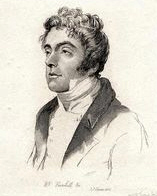Travels in the Interior of Southern Africa. 2 vols. London: Longman, Hurst, Rees, Orme & Brown, 1822-1824.

The author, during this expedition, which lasted four years, had no companion or assistant, nor other attendants than a few Hottentots, the number of whom never exceeded ten. Of the party which set out from Cape Town, he was the only one who returned to that place; the rest having quitted him, and been several times replaced by others on the journey. In a course of four thousand five hundred miles, exclusive of numerous smaller excursions, regions never before trodden by European foot, were explored and examined.
—Burchell (Vol. 1, p. vii))
Born outside London, where his father ran a nursery, Burchell developed into an outstanding naturalist and artist. In 1805, he was hired by the British East India Company to be schoolmaster and botanist at the South Atlantic Ocean island of St. Helena. While there, he obtained permission from the Dutch colonial authorities in Cape Town (South Africa) to extensively explore the interior of the colony. He reached Table Bay on 13 November 1810 and spent a number of months making preparations and acquiring the colonial patois which would enable him to converse directly with the inhabitants.
With a well-equipped frontier wagon and a small party of native tribesmen, Burchell commenced his travels on 18 June 1811. He trekked across the Karroo Desert, crossed the Orange River, traversed Bósjesman (Bushman) country, and spent some time among the Bachapins at Latákun in Bechuanaland (today’s Botswana). His published journal ends with him leaving the Bachapins on 3 August 1812, but his travels extended another three years. During that time he amassed a collection of 63,000 specimens of plants and animals, made 500 drawings, and added numerous astronomical and meteorological observations to his notes. In 1817, after his return to England, he presented the British Museum with selected items from his collection. Burchell later made a lengthy trip through South America. His memory is perpetuated in the scientific names of many animal and plant species he discovered.